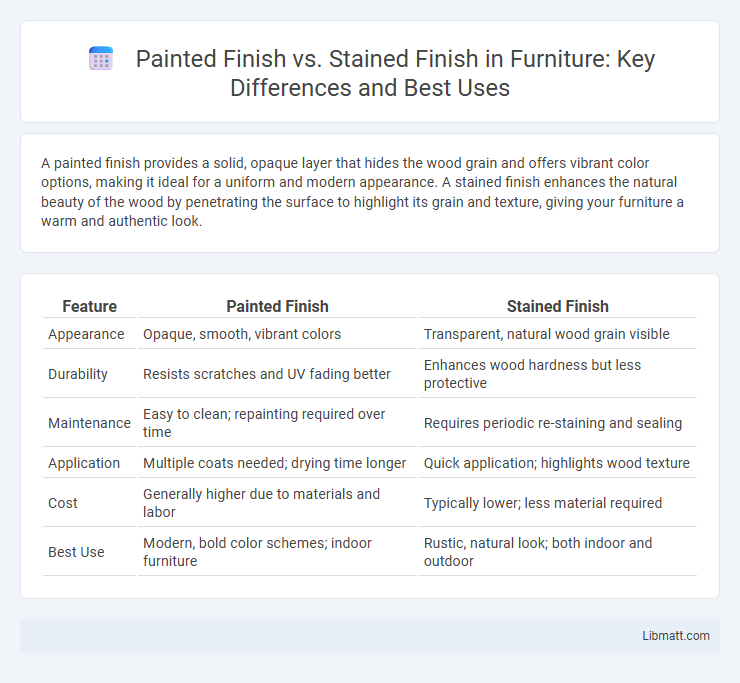A painted finish provides a solid, opaque layer that hides the wood grain and offers vibrant color options, making it ideal for a uniform and modern appearance. A stained finish enhances the natural beauty of the wood by penetrating the surface to highlight its grain and texture, giving your furniture a warm and authentic look.
Table of Comparison
| Feature | Painted Finish | Stained Finish |
|---|---|---|
| Appearance | Opaque, smooth, vibrant colors | Transparent, natural wood grain visible |
| Durability | Resists scratches and UV fading better | Enhances wood hardness but less protective |
| Maintenance | Easy to clean; repainting required over time | Requires periodic re-staining and sealing |
| Application | Multiple coats needed; drying time longer | Quick application; highlights wood texture |
| Cost | Generally higher due to materials and labor | Typically lower; less material required |
| Best Use | Modern, bold color schemes; indoor furniture | Rustic, natural look; both indoor and outdoor |
Introduction: Painted vs Stained Finishes
Painted finishes provide an opaque, solid color that effectively conceals wood grain, offering a uniform and vibrant appearance ideal for covering imperfections. Stained finishes penetrate the wood surface, enhancing natural grain patterns and textures while allowing the organic beauty of the wood to remain visible. Your choice between painted and stained finishes depends on whether you prioritize color variety and coverage or preserving the wood's natural character and warmth.
Defining Painted and Stained Finishes
Painted finishes create an opaque, solid color layer on surfaces, effectively hiding the natural grain or texture of the material beneath. Stained finishes penetrate the surface, enhancing and highlighting the wood's natural patterns and color variations while adding protection. Choosing between painted or stained finishes depends on the desired aesthetic, durability, and the type of wood or material being treated.
Aesthetic Differences: Color and Texture
Painted finishes offer a solid, opaque color that completely covers the wood grain, creating a smooth and uniform texture ideal for vibrant or muted tones. Stained finishes enhance your wood's natural grain and texture, allowing the natural patterns and imperfections to show through while adding depth and richness to the color. Choosing between painted and stained finishes depends on whether you prefer a consistent, bold look or a more organic, textured aesthetic that highlights the wood's unique characteristics.
Durability and Maintenance Comparison
Painted finishes offer superior durability by providing a protective layer that resists moisture, UV rays, and daily wear, making them ideal for high-traffic areas or outdoor use. Stained finishes penetrate the wood grain, preserving its natural texture while requiring more frequent maintenance to prevent fading and damage from environmental exposure. Your choice between painted and stained finishes should consider the balance between longevity and upkeep based on the specific demands of your project.
Application Process and Materials
Painted finishes require a primer, multiple coats of paint, and a final topcoat for durability, using brushes or rollers for smooth coverage. Stained finishes involve applying a wood stain that penetrates the surface, often followed by a clear protective sealer like varnish or polyurethane, highlighting the natural grain. Your choice affects preparation, drying times, and tools needed, with paint offering opaque coverage and stain emphasizing wood texture.
Cost Analysis: Painted vs Stained
Painted finishes generally incur higher upfront costs due to the price of quality paint and multiple coats required for durability, while stained finishes tend to be more budget-friendly with fewer application steps. Maintenance expenses for painted surfaces often exceed those for stained wood, as paint may need frequent touch-ups to prevent chipping and peeling. Stained finishes enhance the natural grain of wood, reducing the need for repainting and offering better long-term cost efficiency.
Suitability for Different Wood Types
Painted finishes provide a uniform color and are ideal for hardwoods and softwoods with imperfections, as they cover knots and grain inconsistencies effectively. Stained finishes highlight the natural grain and texture, making them more suitable for fine-grained woods like oak, maple, and cherry. Choosing between painted and stained finishes depends largely on the wood type's grain pattern and the desired aesthetic outcome.
Environmental Impact and Sustainability
Painted finishes often contain volatile organic compounds (VOCs) and synthetic chemicals that contribute to environmental pollution and can be harmful to indoor air quality. Stained finishes typically use natural oils or water-based formulas with lower VOC levels, making them a more sustainable choice for preserving wood while reducing ecological impact. Choosing a stained finish can help you minimize environmental harm and promote healthier living spaces through eco-friendly materials.
Popular Trends in Interior Design
Painted finishes dominate popular interior design trends with their versatility in color options and ability to create a sleek, modern look that complements minimalist and contemporary styles. Stained finishes remain favored for showcasing natural wood grain, adding warmth and organic texture to rustic, farmhouse, and traditional interiors. Current design movements often blend painted cabinetry or furniture with stained wood accents to balance bold color statements and natural beauty.
Choosing the Right Finish for Your Project
Selecting the right finish for your project depends on both aesthetic goals and durability needs; painted finishes offer vibrant, opaque coverage ideal for hiding imperfections, while stained finishes enhance natural wood grain with varying transparency and color richness. Consider environmental factors and surface type--paint creates a protective barrier against moisture and UV damage, making it suitable for outdoor furniture, whereas stains penetrate wood, preserving its texture and requiring regular maintenance. Understanding these differences ensures your chosen finish complements the project's function and desired visual impact.
painted finish vs stained finish Infographic

 libmatt.com
libmatt.com